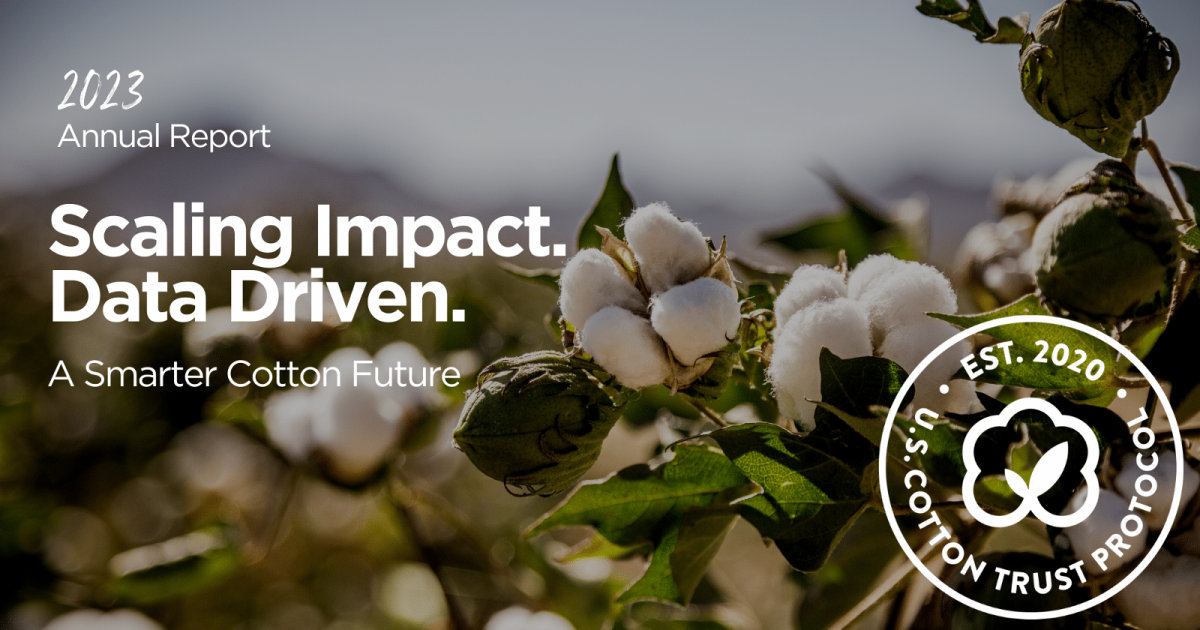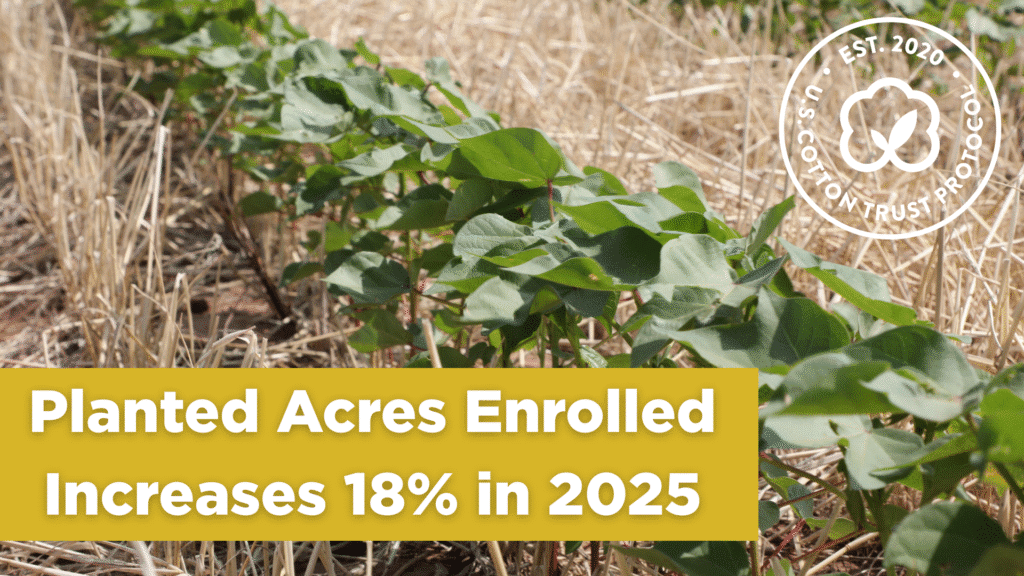- Enrolled grower numbers tripled compared to 2020 launch, with 975 growers enrolling almost a quarter of entire U.S. cotton acreage; all 17 cotton-growing states represented
- Key improvements on 2015 baseline figures reported are: a reduction in soil loss of 79%; 83% of Protocol growers seeing positive soil carbon index; yields +12% on national average; water efficiency up 14%; 27% reduction in energy use, and GHG emissions down 21%
- Data reported in the U.S. Cotton Trust Protocol’s third Annual Report
Memphis, TN, February 6, 2024 — The U.S. Cotton Trust Protocol has tripled its grower membership in just three years, whose 1.7m acres now represent almost a quarter (23%) of the entire cotton-growing area of the United States. And while it has expanded enrolled planted acres exponentially, the program continues to drive progress across its six metrics. These are just some of the headline results published today in the U.S. Cotton Trust Protocol’s third Annual Report.
Continued improvement across all six metrics
The program reported continued progress across all six metrics of land use; water use efficiency; energy use; greenhouse gas emissions; soil conservation, and soil carbon. Aggregate improvements on 2015 baseline figures reported are: a 79% reduction in soil loss with yields 12% greater than the national average; 83% of Protocol growers reporting a positive soil carbon index, water use efficiency enhanced by 14%, GHG emissions cut by more than a fifth (21%), and a 27% reduction in energy use. See notes to editors for further details.
Regenerative agriculture metrics
The Trust Protocol’s Annual Report also includes key metrics on progress in regenerative agriculture using Field to Market methodology. The regenerative practices reported include cover cropping; minimal or no-tillage methods; promoting biodiversity; rotational farming; precision agriculture techniques; Integrated Pest Management, and using inputs tailored to specific landscape conditions. See notes to editors below for further details.
Aggregate data reporting in the context of an enlarged data set
The tripling of enrolled growers brings significant implications for data interpretation. More participating growers contribute to a larger data set which impacts the statistical significance of the findings. The diversity of practices with a large and broader group of growers also means there is a greater representation of farming practices, regions, conditions, which in turn helps improve data interpretation and allows for benchmarking. At the same time an unusually high or a low value in a single year of exponential growth in enrolled grower members can lead to data anomalies. Aggregate data reporting over a three-year period ensures a reduced impact of anomalies as more data is incorporated into the program.
Commenting on the results, U.S. Cotton Trust Protocol’s Executive Director Daren Abney said: “I’m greatly encouraged by the continued progress, and not least by the exponential growth in enrolled planted cotton acres. Accurate data collection sets the stage for appropriate decisions for brands and retailers, where they can claim how much water has been saved or how many greenhouse gas emissions have been reduced. Today’s data demonstrates how Protocol growers continue to improve in their environmental performance, year on year. We do not have a final destination: our journey is one of continuous improvement in the pursuit of excellence.”
—ends—
Notes to editors
Key sustainability metrics in detail
Land use During the 2022/23 cotton growing season Trust Protocol growers used 43 square feet to produce a pound of cotton fiber. While this mirrors 2021/22 figures and indicates a consistent trend for the program as a whole, it is noteworthy that six in ten (61%) of Trust Protocol growers used less than 41 square feet per pound, indicating increased progress across a significant majority of member growers. The Trust Protocol established a baseline average land use of 48 square feet per pound of cotton. Land-use efficiency is closely associated with yield. In the 2022/23 growing season Trust Protocol growers achieved a 12% higher yield than the national average[1]. This was a considerable achievement considering the significant environmental challenges faced during the season, including drought causing water stress and stunted plant growth. Trust Protocol growers have consistently outperformed the U.S. average yield over the past three years.
Water use efficiency Trust Protocol growers increased water use efficiency by 14% – similar to the progress made in 2020/21 – achieving an aggregate 0.018 pounds of fiber per cubic foot of water, thereby reducing water use to 56 cubic feet for each additional pound of cotton produced. The 2025 National Goal aims to increase water use efficiency by 18%, or 53 cubic feet for each additional pound of cotton. Irrigated Fieldprint acres accounted for 62% of the total harvested acres (458,176 non-abandoned acres), while non-irrigated acres made up the remaining 38%.
Energy use Trust Protocol growers achieved a 27% reduction in energy consumption during the 2022/23 cotton growing season, surpassing the 2025 National Goal of a 15% reduction. Collective energy use stood at 5,836 Btu per pound, a notable improvement on the 2015 baseline of 8,049 Btu/lb. The energy use metric evaluates all energy expended throughout the entire production cycle of a single crop within a given year, encompassing activities from pre-planting to post-harvest.
Greenhouse-gas emissions Trust Protocol growers reduced GHG emissions by 21%, marking a significant step towards the overarching 2025 National Goal of a substantial 39% reduction compared to the 2015 baseline. Aggregate GHG emissions per pound of fiber for Trust Protocol growers stood at 1.9 CO2e. The GHG metric provides a comprehensive assessment of total emissions from four primary sources within crop production: energy use; nitrous oxide emissions from soils; methane emissions (specifically from flooded rice fields), and emissions arising from residue burning.
Soil conservation In the 2015 Trust Protocol baseline average soil loss was recorded at 12.6 tons/acre/year. An ambitious objective to reduce soil loss by 50% by 2025 was set. In 2022/23 aggregate soil loss was just 2.6 tons per acre per year, a remarkable 79% reduction in soil loss compared to the 2015 baseline. This achievement underscores Trust Protocol growers’ commitment to adopting innovative techniques to enhance soil health.
Soil carbon In the 2022/23 cotton growing period Trust Protocol growers achieved an SCI of 0.2, similar to the Trust Protocol aggregate data in 2020/21 and 2021/22, indicating continued improvement in soil health. Particularly noteworthy is that in 2022/23 a substantial 83% of Trust Protocol growers’ acreage demonstrated a positive SCI. The Trust Protocol had set a target of 30% of growers showing SCI improvement by 2025 on a 2015 baseline SCI of -0.4. Soil carbon is crucial in supporting water infiltration, nutrient retention, crop productivity, and carbon storage. Quantifying changes in soil carbon is complex and is done using the Soil Conditioning Index (SCI). The metric considers three significant factors influencing soil carbon: organic matter and crop residue returned to the soil; soil erosion caused by water and wind, and the impact of field operations, including tillage intensity. SCI provides a value between -1 and 1 for each field, where positive values indicate increasing soil carbon, zero suggests maintenance, and negative values soil carbon loss. The magnitude of the index reflects the confidence in the direction of change, not the absolute amount of carbon.
Key regenerative agriculture metrics in detail
- Approximately 15% of Trust Protocol Fieldprint acres practiced conventional tillage; some 22% of reported Fieldprint acres adopted reduced tillage (a hybrid of conventional tillage and no-till practices); and a substantial 63% of Fieldprint acres implemented no-till practices.
- Cover crop adoption in the 2022/23 Fieldprint reported acreages has gone up by 19% in comparison to 2021/22 and by 15% in comparison to 2020/21. A noteworthy 70% of Trust Protocol Fieldprint acres embraced cover crops, while 30% did not incorporate any cover crops into their farming practices.
- Conventional crop rotation practices were employed in approximately 86% of the reported Fieldprint acres, aiming to foster a more diverse and healthy microbial community in the soil. In cotton cultivation rotation commonly includes peanuts, sorghum, winter wheat, soybeans and corn, with selection depending on the region.
- Integrated pest-management strategies (IPM) were employed in 45% of the reported Fieldprint acreage. Four percent of the acreage utilized IPM strategies without chemical control, 33% relied primarily on chemical control but also incorporated site-specific techniques to mitigate environmental risks associated with pesticides, and 18% were primarily managed through chemical control alone.
- In terms of greater precision in the application of nutrients, 92% of growers employed a nutrient management plan and 97% of the reported Fieldprint acres adhered to one or more of the 4Rs principles (right source, time, rate and place).
- Biodiversity is quantified via the Habitat Potential Index (HPI) which assigns values in the range of 0 to 1: Trust Protocol growers reported an average HPI of 0.66.
- Lastly, for conservation practices and water quality, 7% of Trust Protocol growers’ reported Fieldprint acreage achieved successful mitigation of all four soil loss pathways. Another 25% indicated the successful mitigation of three out of four loss pathways (surface Phosphorus, sub/surface Phosphorus, surface Nitrogen, and subsurface Nitrogen).
About the U.S. Cotton Trust Protocol
The U.S. Cotton Trust Protocol is a voluntary, farm level science-based sustainability program that is setting a new standard for delivering value to all stakeholders across the entire supply chain from farms to finished products. It is the only system that provides quantifiable, verifiable goals and measurement and drives continuous improvement in six key sustainability metrics – land use, soil carbon, water management, soil loss, greenhouse gas emissions, and energy efficiency. It is also the world’s first sustainable cotton fiber program to offer article-level supply chain transparency to all members. The Trust Protocol is overseen by a multi-stakeholder Board of Directors comprised of representatives from brands and retailers, civil society, and independent sustainability experts as well as the cotton-growing industry, including growers, ginners, merchants, wholesalers and cooperatives, mills, and cottonseed handlers.
Media Contacts:
Andrea Miles, Andrea.Miles@hkstrategies.com, +1 (213) 300-1507
[1] reported by the United States Department of Agriculture’s National Agricultural Statistics Service (USDA-NASS).





